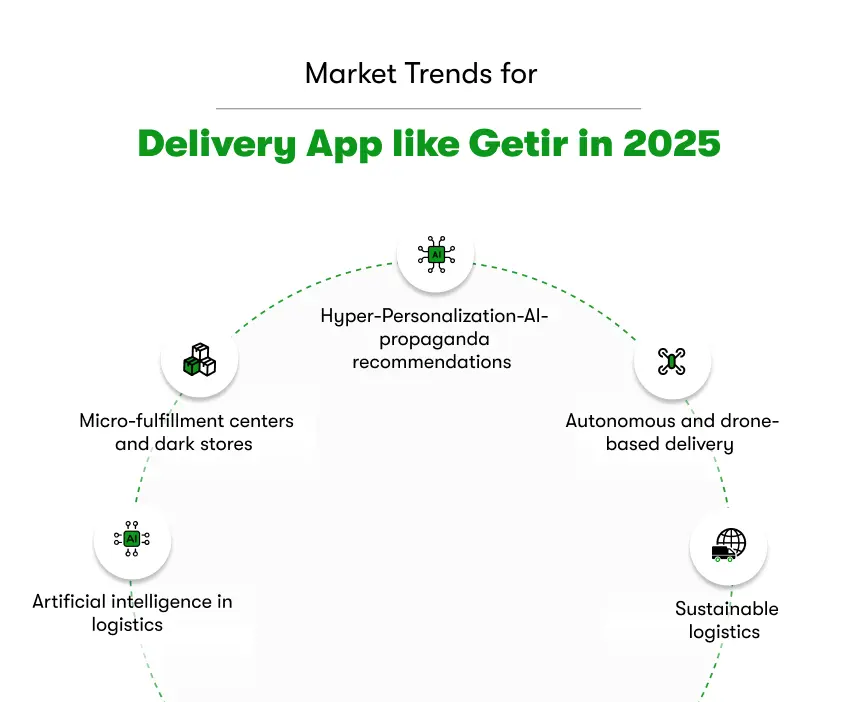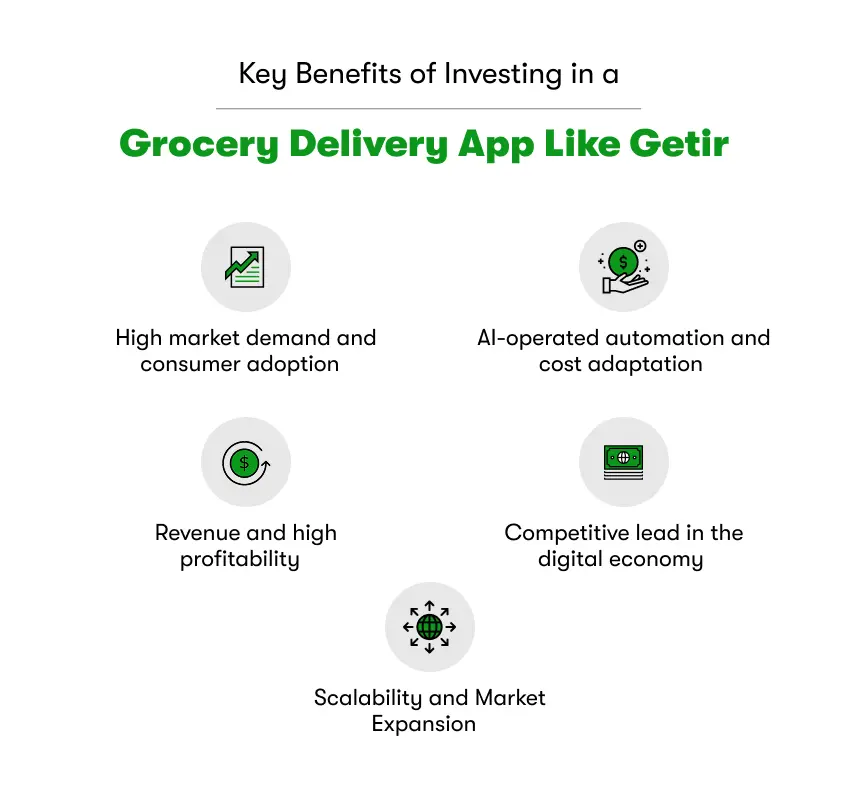The Quick-Commerce (Q-commerce) industry has again shaped how consumers shop for daily necessities. Delivery app like Getir, Gorillas, Gopuff and Blinkit has set new expectations for speed and convenience, promising delivery in 10 minutes with services. Since businesses compete to capture the increasing demand for rapid delivery, grocery delivery app development offers an exciting opportunity in 2025.
Quick Commerce Market is estimated to hit the US $ 195.01BN in revenue by 2025. With 8.05% CAGR (2025–2029), it is expected to reach US $ 265.84BN by 2029. (Statista)
Development of rapid delivery apps
A decade ago, online shopping was mainly about the same day or the next day’s delivery. The introduction of platforms such as Instacart and Amazon Fresh changed grocery purchases on a button tap. However, modern consumers now want even faster services, which led to the rise to make an app like Getir for instant delivery.
Unlike traditional e-commerce, these rapid distribution services function through a hyperlocal supply model. Instead of shipping products at a distance of miles from large warehouses, they store inventory in a micro -warehouse (dark stores) strategically placed within high-deserved urban areas. This allows them to fulfil the orders within minutes, making them simplify everyday purchases such as food orders.
Market Growth and Trends in 2025

The quick-commerce industry is experiencing unprecedented growth. According to market reports, the global market is expected to reach $500 billion by 2030, which is fueled by increasing demand for immediate access to grocery accessories, medicines and daily essentials.
With consumer expectations moving towards on-demand features, many industry trends are rapidly shaping the future of grocery app development:
- Artificial intelligence in logistics – AI is now being used to predict demand patterns, optimize distribution routes and automate warehouse management, which reduces operating costs by improving efficiency.
- Micro-fulfillment centers and dark stores– More carriers are investing in local warehouses, allowing them to store inventory close to customers and cut off the time of delivery.
- Autonomous and drone-based delivery- Companies are searching for drone technology and autonomous distribution robots to speed up final meal delivery.
- Sustainable logistics -With growing environmental concerns, brands are transitioning to electric delivery vehicles and environmentally friendly packaging.
- Hyper-Personalization-AI-propaganda recommendations– Dynamic pricing, and voice-active orders improve customer engagement and retention.
Why Is Demand Rising for Grocery Mobile App Development?
In recent years, consumer priorities have changed dramatically; urban lifestyle has demanded a rapid and more efficient solution. The rise of immediate distribution services can be attributed to many factors:
- Urban lifestyle and convenience – In cities, people lack time to visit physical stores for groceries and necessities. The 10 -minute delivery services eliminate this problem.
- Post-pandemic shift- Accelerated the adoption of online grocery, without contact, rapid delivery gave a favorite option to many people.
- Tech advancement- AI, real-time tracking, and future analytics have made immediate distribution operations more efficient and scalable.
- Platforms such as membership-based models- Getir More, Blinkit Pass, and Gopuff FAM offer exclusive deals, free delivery and priority services, increasing loyalty and retention.
- Prominent e-commerce- Players such as Amazon and Wal-Mart, are entering the quick-commerce space, making it a highly competitive and attractive industry.
Why Build a Rapid Grocery Delivery App Like Getir?
The demand for immediate delivery is stronger than ever. A busy lifestyle, urban features, and post-pandemic digital adoption have made grocery mobile app development one of the fastest-growing sectors in the e-commerce industry. Companies investing in grocery app development not only meet the needs of customers but also exploit a high-revenue business model with many modification opportunities.
Key Benefits of Investing in a Grocery Delivery App Like Getir

1: High market demand and consumer adoption
Consumer behavior has moved towards on-demand facilities, in which people prefer to order online instead of going to physical stores. Apps such as Getir, Gopaf and Blinkit have proved that ultra-fast delivery is a large market, and this demand is expected only to grow.
2: Revenue and high profitability
A Getir-like grocery delivery app development can generate revenue through the App:
- Distribution fee – Charge the user on the basis of order size, distance or delivery time.
- Surge pricing – Apply dynamic pricing during peak hours.
- Sellers Commission – Earn a percentage from local grocery stores and supermarkets for each order processed.
- Allow the in-app advertising brands to promote their products within the App.
- Membership Model – Provide premium services such as free delivery, exclusive deals and priority access through a membership program (e.g., GetirMore).
3: Scalability and Market Expansion
Unlike traditional grocery stores, the delivery app like Getir is highly scalable. You can start in a city, test the market, optimize operations and then expand into new areas. Additionally, the model can be adapted to:
- Grocery delivery
- Restaurant Food Delivery (Getter Yemek Model)
- Pharmacy and medical supply distribution
- Pet supply and domestic essential distribution.
4: AI-operated automation and cost adaptation
With progress in AI and machine learning, grocery mobile app development is becoming more efficient and cost effective. Features such as Predictive Inventory Management, AI-Pure Route Optimization, and Smart Demand Forecasting help to reduce operational costs by improving efficiency.
5: Competitive lead in the digital economy
Investing in a grocery app development allows you:
- Compete with major grocery chains and e-commerce giants.
- Install brand loyalty through better user experience and personal recommendations.
- Used data-managed decision-making to increase marketing, inventory management, and logistics.
With a business model similar to business model for Getir yemek app, and technical infrastructure, make an app like Getir can lead to your business’s long-term success in the rapidly growing quick-commerce industry.
Business Model for Getir Yemek App
Choosing the right business model is crucial in developing an application like Getir. The Getir Yemek app model relies on hyperlocal delivery, essentially for groceries and meals delivered from nearby fulfillment centers directly to customers in a matter of minutes.
Here’s a breakdown of the key business model for Getir yemek app:
Marketplace model (third-party distribution aggregator)
In this model, your App combines restaurants with local grocery stores and customers. You act as an intermediary, handling orders, payments and delivery logistics while traders list your products on your platform.
How it works:
- Customers place orders from partnership grocery stores or restaurants.
- The order has been assigned to a delivery partner to fulfil it.
- You earn a commission from each transaction.
Pros:
- Lower inventory and logistics costs.
- Quick scalability with a wide vendor network.
- Flexible revenue models (delivery fees, commissions, ads).
Cons:
- Higher reliance on third-party vendors for quality and availability.
- Requires strong vendor onboarding and partnerships.
Best for: Entrepreneurs are looking to create a grocery delivery app without managing warehouses or inventory.
Inventory-LED Model (Dark Store Concept of Getir)
This model is the origin of Getir’s success. Instead of listing the third-party store, you manage your own inventory via a micro-film fulfilment center (dark store). The orders are directly completed from these strategically located hubs, which ensure rapid delivery and better inventory control.
How it works:
- Customers order grocery goods from your own list.
- Orders are processed through AI-Interacted Supply Centers.
- Delivery riders raise orders from the nearest dark store.
Pros:
- Faster order fulfilment with better logistics control.
- Higher profit margins as you control pricing and stock.
- Improved customer loyalty and brand value.
Cons:
- High initial investment in warehouses and logistics.
- Requires advanced inventory and supply chain management.
Good for large-sized grocery delivery startups that have full control of photographs for speed.
Hybrid Model (Marketplace + Dark Store + Restaurant Distribution)
A combination of marketplace models and inventory-LED models, it is ideal for businesses looking to expand several delivery segments (groceries, restaurant food, pharmacy items, etc.).
How it works:
- Grocery orders are completed through both the dark store and the partner store.
- Delivery of restaurant food is managed like Uber Eats or DoorDash.
- Users can use multiple delivery services in one App.
Pros:
- Maximizes revenue potential from multiple verticals.
- Offers faster fulfilment while scaling through partnerships.
- Attracts a larger customer base looking for one-stop convenience.
Cons:
- Requires complex tech infrastructure to manage multiple services.
- Higher operational challenges due to different logistics requirements.
Best for: Companies looking to create multi-service, on-demand delivery apps like Gateri Yamek

What Are the Must-Have Features Grocery Delivery App Development?
The construction of a gear-like rapid delivery app is more than only ordering and getting an interface to order. The success of such an app depends on an integrated ecosystem that ensures efficiency in order, dispatch and delivery while maintaining uninterrupted operation behind the curtain. A high-demonstration Grocery Mobile App Development Project requires three essential components:
- Customer app– a sharp, spontaneous and AI-operated shopping experience.
- A well-adapted system for delivery partner app-supporting order fulfillment.
- Administrator Panel – a control center for managing inventory, delivery and commercial performance.
Each of these components plays an important role in shaping user experience and commercial profitability. Let us dive into the essential facilities that make the delivery app like gaiter successful.
The Customer App:
A customer application is the user interface through which a customer searches products, orders, monitors deliveries, and pays. To be able to compete with quick-commerce giants such as Getir and Gopuff, it is very crucial that the experience is seamless, user-friendly, and personalized.
1: AI-Powered Smart Search & Categorization
The application will arrive with AI-powered recommendations ranging from the order of past purchases and trending items to seasonal demand. By integrating voice and image detection, the App can further help users look up products and make purchases as rapidly and conveniently as possible.
2: One-tap ordering and cart management
For grocery delivery apps like Getir, the speed is everything. Customers should be able to add items to their car with a tap and do it easily. A feature that often recalls purchased products allows to be rapidly rearranged. Additionally, an option to schedule orders in advance can help customers to plan their grocery needs efficiently.
3: Many Payment Options and Safe Transactions
A mobile app development project is incomplete without spontaneous payment integration. The App should accept credit/debit card, UPI, mobile wallet, Buy now pay later (BNPL), and even crypto payments. End-to-end encryption ensures safe transactions while auto-paying options allow rapid checkouts.
4: Real-Time Order Tracking & ETA Updates
Customers expect accurate information about their orders. Real-time GPS provides a visual representation of the tracking delivery route, while automated ETA updates inform users. If delivery is delayed, the App should send active information with causes and revised estimates.

5: Chat and customer service within the App
Providing excellent customer service is important to maintain users. Software should support human agents for high-level issues and provide in-app chat guidance through AI chatbots to answer timely questions. In case of order change or logistics issues, direct contact with the delivery partner can help improve communication.
6: Loyalty Programs & Personalized Discounts
A membership-based prize program, like GetirMore, can help increase customer retention. Lawyers encourage the orders of repeating exclusive deals based on marks, personal discounts, and shopping patterns. AI-powered insight may recommend special proposals based on previous purchases, improving users’ busyness and sales.
7: Push Notifications & Smart Alerts
In the feature of intelligent alerts and push notifications are messages sent to the consumers talking about the status of confirmation, discount, distribution, and restoration. AI could inform users about low-stock products and provide suggestions regarding their discount offers depending on browsing history, thus making the application one of the most important components in daily living for the user.
8: Multi-Language & Multi-Currency Support
For target businesses that target many areas, offering multi-language support and currency conversion increases access. A well -known localized App can improve user experience and brand reliability in global markets.
A well-designed customer app ensures the use of repeating, customer retention and brand loyalty, making it the original of any grocery delivery app development strategy.
The Delivery Partner App:
For best food delivery app, ensuring smooth and efficient delivery is simply as important as a shopping experience. Delivery partners must have access to a well-designed App that helps them to accept orders, navigate customized routes and track easily.
1: Easy registration and onboarding
Delivery partners should be able to sign up quickly using their phone number, email or social media accounts. An underlying KYC verification system allows the document upload, background check and vehicle registration, which makes the onboarding process uninterrupted.
2: Smart order allocation and route optimization
The application should use the AI-interested algorithm to order proximity, traffic status and order priority. Integrated navigation tools such as Google Maps help drivers find the fastest route, causing delays and fuel costs.
3: Real-time order tracking and status update
Drivers must be able to update the order position at each step from pickup to delivery. This feature ensures better communication with customers, while the administrator allows to monitor the progress of order in real time.
4: Earning dashboard and payment management
Transparent earnings allow dashboard delivery partners to track their income, bonuses and tips. The App should also include immediate payment options through bank transfer or digital wallet, which ensures financial flexibility.
5: In-app chat and call support.
To improve communication, the App must include a safe in-app calling and chat option for the driver, customer, and support team. This helps solve issues such as wrong addresses or payment concerns in real time.
6: Security facilities and emergency SOS
For driver safety, an emergency SOS button should be integrated. This facility allows distribution partners to support officers or teams in case of accidents, road events, or dangers.
A well-designed delivery partner app ensures that the order comes on time, is busy and motivates the task force.
The Admin Panel:
The administrator serves as the command center of the panel business, overseeing inventory, order, delivery, payment and analytics.
1: AI-Inventory and Order Management
A smart inventory system should provide real -time stock updates to ensure that popular items are not run unexpectedly. The AI-operated demand can predict the trends of the forecast sales and automatic restoration.
2: Dynamic pricing and discount management
Admins must have flexibility to accommodate pricing based on demand, location and stock availability. Customers can sell more and create a discount campaign.
3: Live delivery tracking and operation monitoring
The administrator panel should allow businesses to track every order in real-time. A hen-map delivery of high-blood areas can help customize the delivery route and assign drivers more efficiently.
4. Sales and performance
The App must give detailed sales reports, user engagement and delivery efficiency. AI-manual insight can highlight customers’ trends and potential development areas.
5. Customer and delivery partner management
Admins should be able to handle disputes, review complaints and manage the performance of the delivery partner from single dashboard.
A powerful administrator panel ensures smooth business operations and efficient scaling for prolonged development.
Step-by-Step Process to Develop a Rapid Delivery App
Step 1: Market Research and Competitive Analysis
Prior to development, research your target audiences, competitors, and market trends. To understand their strength and gaps, analyze successful rapid delivery apps like Getir, Joke, and Gopuff. Customers do surveys to identify pain points and expectations, such as delivery speed, product availability and pricing.
- Study customer preferences and purchase behavior.
- Identify major contestants and analyze their business models.
- Research legal and regulatory requirements.
Step 2: Define Your Business Model
Choose a business model that align with your goals. A B2C model stores customers directly, a marketplace model allows several vendors on the platform, and a hybrid adds both. Define your revenue currents, such as delivery fees, commission, or membership-based services.
- Choose between on-demand, scheduled or hyperlocal delivery.
- Plan partnerships with vendors and logistics providers.
- Define mediation strategies (advertising, premium membership, etc.).
Step 3: Choose the right technical stack
Selecting the right technology stack ensures a scalable, safe and high-demonstration app. For the front-end, use pulsing or reacting native; For the backend, choose the option of larger, node.JS, or python. Use navigation for payment and Google Maps API for Stripe or Regrape.
- Select a cloud-based solution for better scalability.
- Use real-time database management such as Firebase or PostgreSQL.
- Apply strong safety protocols for safe transactions.
Step 4: UI/UX Design & Wireframing
A well-designed App should be comfortable and sharp. Use Figs, Adobe XD, or Sketch to make a wireframe and prototype. Pay attention to a spontaneous user experience with simple navigation, quick checkouts and real-time tracking.
- Priority to fast-based screening and smooth infections.
- Apply accessibility-friendly design principles.
- Ensure mobile-first responsible UI.
Step 5: Development in Core
Food delivery app development company should ensure necessary features for customers, distribution agents and Admins. Customer app should include order placements, real-time tracking, many payment methods and information. The delivery agent app should support order acceptance, route adaptation and earning tracking. The administrator manages the panel users, vendors and analytics.
- First, create an MVP (minimum viable product).
- Ensure highly customized search and filter options.
- Apply multi-speaking and multi-currency support if necessary.
Step 6: AI and integration of automation
Increase efficiency with AI-powered route optimization, automatic inventory updates and chatbots for customer assistance. Use AI in Food Delivery App to predict often purchased items and delivery time based on previous orders.
- Use machine learning for demand forecast.
- Integrate AI-operated fraud detection in the payment.
- Automatic push notice and personal promotion.
Step 7: Testing and Quality Assurance
Test the App completely for bugs, performance, safety and purpose. Conduct functional, UI, load and entry tests. The beta test with real users helps to refine the food delivery app solution before the full-scale launch.
- Do cross-platform tests for Android and iOS.
- Use automatic testing devices for regression testing.
- Test the test payment gateway, location accuracy and server response time.
Step 8: Launch and Marketing Strategy
Launch the App with a soft launch in selected areas before the full-scale release. Apply app store optimization (ASO) for better visibility. Use social media, referral programs and Google advertisements to attract users.
- Adapt the app details, screenshots and keywords for ASO.
- Participate or promote with influential people to attract early adopters.
- Collect the user response and apply a quick fix post-launch.
Step 9: Post-Launch Support & Scaling
Monitor the user response and analyze the app performance with analytics tools. Regular updates release regular updates to improve performance and add new features. Extend to new areas and participate with more vendors to score the business.
- Provide customer aid through in-app chat, email or call.
- Apply data-operated strategies for expansion.
- Add AI-driven privatization to increase user connectivity.
The Role of AI & Automation in Quick-Commerce
- AI and automation are changing quick-commerce by increasing speed, efficiency and accuracy. The new trends in food delivery apps demands forecast customized inventory, reduces wastage and stock deficiency. Automatic supply centers and robotic sorting systems accelerate order processing, improve delivery speed.
- The last-mile delivery AI-driven route assists the ad hoc courier in traffic route navigation and is expected to save more than 30% of delivery time. AI chatbot and virtual assistant customers manage assistance, directly respond to questions raised, and reduce human intervention. Fraud detection systems guard transactions from unwanted activities.
- Machine learning-driven personal shopping experiences enhance user engagement and provide suitable product recommendations and dynamic discounting. Dynamic pricing models further adjust distribution fees up and down according to changing demand.
- Automation reduces operational costs, optimize management, and order fulfillment efficiency. AI-operated logistics ensure that businesses may quickly scares with uninterrupted user experiences, making it an essential technique for gayer-like grocery delivery app development.
Cost Estimation for Developing a Getir-Like App
- Estimating a rapid delivery app like that of Getir involves the consideration of features, complexity, and the location of the development team. In very general terms, we are looking at anything between $30,000 to $50,000 for a simple MVP with core features such as user registration, product search or order tracking. Conversely, a project with AI logistics, automation, and real-time analytics would range from $50,000 to $100,000+.
- Food delivery app development cost factors include UI/UX design ($ 5,000 – $ 15,000), Frontend & Backend Infrastructure ($25,000 – $ 80,000), API integration for payment, maps and chatbots ($ 5,000 – $ 20,000+), Testing & Quality Assurance ($10,000 – $20,000), Deployment & Maintenance ($5,000 – $15,000 annually), and AI integration also adds the cost.
- Outsourcing development for India or Eastern Europe is more cost effective than hiring teams in North America or Western Europe. The best way is to start with an MVP, gather the user response, and scale with advanced features to optimize costs and maximize ROI.
Future of Rapid Delivery Apps Beyond 2025
- The accelerated-commerce industry is ready to develop with AI, automation and stability-powered innovations. Drone delivery and autonomous vehicles will improve the fulfillment of the last mile, the cost and distribution time will be reduced. The AI-operated hyper-Personalization will increase customer experiences, predicting orders before placing users.
- The blockchain will secure technology transactions, the supply chain will improve transparency, and automate the seller payment using smart contracts. Environmentally friendly delivery fleet and permanent packaging industry will become standard as businesses focus on reducing carbon footprints.
- Super apps integrating grocery, food, pharmacy and ride-sharing services will domi nate, which provide all-in-one facility. The expansion in semi-urban and rural markets will run future development, supported by the AI-operated logistics and micro-film-filming centers.
- By 2030, the rapid delivery will be transferred from speed-based competition to service discrimination, focusing on privatization, efficiency and stability. Business hugging automation and emerging technology will lead the next stage of quick-commerce development.












 Contact Information
Contact Information